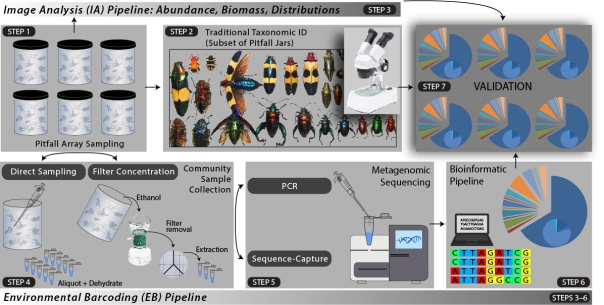Caption: Five Geographical Ecologists from OU’s Dept. of Biology and investigators on our new macrosystems grant. L-R: Michael Kaspari, Matt Miller, Michael Weiser, Katie Marshall, and Cam Siler.
The backstory behind our latest NSF-Macrosystems funded project
Insects are among the most abundant and ecologically important animals in the biosphere. Insects pollinate plants and decompose them back into soil. They include serious crop pests and invasive species that cause countless millions in damage. A key goal of macroecology is to understand how and when the number and activity of insects change as one moves from place to place across the U.S., and why those numbers fluctuate from year to year. Such an understanding can help predict insect pest outbreaks, the spread of invasive species, and changes in an ecosystems ability to provide food and fiber and conserve soil nutrients.
Yet macroecological datasets vastly underrepresent the terrestrial invertebrates. This reflects a lack of sampling effort (boots on the ground collecting insects) and identification expertise (eyes in the lab counting and recording them).
Thanks to the NEON pitfall network, 47 invert sampling arrays now span the U.S.’s major ecosystems, collecting insects in pitfall traps. These traps–sunk flush with the soil surface–capture biweekly samples throughout the growing season of each site. We believe these samples are the first step toward a new flourishing invertebrate macroecology. But, beside the carabid beetles, these samples currently consist of jars of bugs in alcohol. For the first time, we have the potential to understand both seasonal and annual invertebrate dynamics at a continental scale. If we could just count, size, and identify all those bugs in all those jars.

The geography of the NEON pitfall trap network. (A) Distribution of monitoring sites in the NEON Pitfall Network (Note: Sites outside of continental US not shown above). (B) Example of site-specific pitfall array. (C) Illustration of individual, pooled jar of macroinvertebrates collected in pitfall array.
The second step
We call the project NEONinverts*. We will endeavor to develop two complementary technologies to turn NEON’s jars of bugs into some classic macrecological variables–abundance, diversity, and body size–and then to test some big continental questions (see below). Each NEON jar is a two-week sample from one of ten arrays from 1 of 47 sites. Only the carabid beetles have been removed. This is an astounding library of ecological information.
In NEONinverts, we will develop two pipelines–a g’mish of technology, databasing, and best practices–that will count, size, and identify taxa from these samples. The first half of our project will be to test, hone, and validate these protocols.

The big picture of our pipeline development.
Environmental Barcoding will extract insect DNA from the alcohol in which the insects steep and use that DNA to put names on the inverts found therein. Environmental barcoding (EB) is a set of tools that allows the identification of biota, not from their tissue, but from the media in which they exist. It has been used to screen for aquatic invasive and endangered species from water samples. More recently, several studies have used EB from arthropod “biodiversity soup”—homogenized samples from insect traps.
We propose to take on the hard problem of non-destructive quantification of diversity and composition from pitfall samples using the ethanol supernatant of preserved macro-invertebrate samples. In doing so, we hope to develop a robust pipeline for characterizing taxonomic diversity not only from pitfall traps, but from any fluid preserved mixed-invertebrate sample. This includes quantifying the nature and magnitude of biases, both taxonomic and environmental.
Image Analysis is a second, complementary method for quantifying pitfall traps samples. It starts with spreading trap contents on a white gridded surface with trap labels and ruler placed in a standard location. Images are captured with an articulating system of 10 PowerShot G7 X Mark II cameras, each with a resolution of 20.1 megapixels from fixed tripod arms with constant lighting conditions. Our first goal will be to use these images to quantify abundance and body size distributions.

The low down on Image Analysis as a tool to identify bugs.
We will then use machine learning–automated algorithms for pattern recognition and classification–to explore our ability to identify taxonomic groups. While machine learning methods for classification are not as accurate as expert examination, they classify orders of magnitude faster than an expert. Like the EB methodology, one of our chief goals is to see how far we can get with current technologies. Just quantifying the the dynamics of different invertebrate orders in time and space will be a huge step forward, but we are confident we can go further than that.
Together, these two pipelines hold the promise of automate and streamlining NEON’s monitoring network, providing the first such nationwide dataset on abundance, activity, and diversity of the U.S.’s soil insects.
Answering macroecological questions with invertebrate data
These data will be potentially valuable to a variety of stakeholders: ecologists testing and refining models that predict future insect communities; land managers who want to know the likelihood of a pest eruption; conservation biologists and urban planners hoping to anticipate spread of invasive ants and beetles.
We are focusing on one uber-question: how do Earth’s great abiotic drivers–temperature, precipitation, and biogeochemistry–govern how ecological communities of individuals and species vary from place to place and over time? The few existing arthropod datasets suggest that as one travels from deserts to rainforests, terrestrial arthropod communities vary by orders of magnitude in abundance (the number of individuals), size (mass per individual), activity (the rate at which individuals do work on the system), and diversity (the number of species/forms). A better understanding of the drivers of each–applied to groups as different as spiders, ants, collembola, and tiger beetles–should help us understand how these taxa regulate ecosystem processes like decomposition, herbivory, and seed dispersal.
Stay tuned.
*Yeah, we know. We are not completely happy with “NEONinverts”. But at least the twitter handle was available.
 The Kaspari Lab
The Kaspari Lab